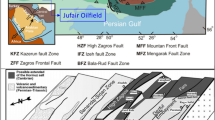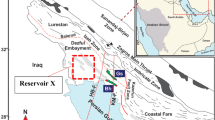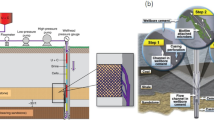Abstract
Tight gas sandstone reservoirs are commonly characterized by complex diagenetic processes, resulting in time-consuming analysis for manual classification and prediction of diagenetic facies types with inherent preference and accuracy limitations. This work explores the feasibility of automatically classifying and predicting diagenetic facies types in tight gas sandstone reservoirs using unsupervised and supervised machine learning models. Firstly, petrophysical and petrological parameters, including porosity, permeability, bulk density, cement content, plane porosity, intergranular volume, and dissolution pore volume were used as input to identify diagenetic facies types automatically through an unsupervised machine learning model based on K-means algorithm. The classified diagenetic facies types exhibited significant diagenetic differences as shown in rock thin sections. Subsequently, with the identified diagenetic facies type as the learning target and logging series data as input, three types of supervised machine learning models were employed to predict the single-well vertical profile of diagenetic facies type distribution. The results indicated that the XGBoost model had optimal performance with the accuracy of 0.87. This work provides a complete automated workflow from basic petrophysical data to complex diagenetic facies profiles based on supervised and unsupervised machine learning models for diagenetic facies type analysis.
















Similar content being viewed by others
Notes
* 1 mD = 1 millidarcy = 9.869233−16 m2.
References
Al-Anazi, A., & Gates, I. (2010a). On the capability of support vector machines to classify lithology from well logs. Natural Resources Research, 19(2), 125–139.
Al-Anazi, A., & Gates, I. D. (2010b). A support vector machine algorithm to classify lithofacies and model permeability in heterogeneous reservoirs. Engineering Geology, 114(3–4), 267–277.
Ali, A., Sheng-Chang, C., & Shah, M. (2021). Integration of cluster analysis and rock physics for the identification of potential hydrocarbon reservoir. Natural Resources Research, 30(2), 1395–1409.
Cao, L., Jiang, T., Wang, Z., Zhang, Y., & Sun, H. (2015). Provenance of Upper Miocene sediments in the Yinggehai and Qiongdongnan basins, northwestern South China Sea: Evidence from REE, heavy minerals and zircon U-Pb ages. Marine Geology, 361, 136–146.
Chen, T., He, T., Benesty, M., Khotilovich, V., Tang, Y., Cho, H., & Chen, K. (2015). Xgboost: extreme gradient boosting. R package version 0.4-2, 1(4), 1-4.
Cortes, C., & Vapnik, V. (1995). Support-vector networks. Machine learning, 20(3), 273–297.
Critelli, S., & Nilsen, T. H. (1996). Petrology and diagenesis of the Eocene Butano sandstone, La Honda basin, California. The Journal of Geology, 104(3), 295–315.
Dev, V. A., & Eden, M. R. (2019). Gradient boosted decision trees for lithology classification. In S. G. Muñoz, C. D. Laird, & M. J. Realff (Eds.), Computer aided chemical engineering (Vol. 47, pp. 113–118). Elsevier.
Di Giuseppe, M. G., Troiano, A., Patella, D., Piochi, M., & Carlino, S. (2018). A geophysical k-means cluster analysis of the Solfatara-Pisciarelli volcano-geothermal system, Campi Flegrei (Naples, Italy). Journal of Applied Geophysics, 156, 44–54.
Garzanti, E. (2019). Petrographic classification of sand and sandstone. Earth-Science Reviews, 192, 545–563.
Grigsby, J. D., & Langford, R. P. (1996). Effects of diagenesis on enhanced-resolution bulk density logs in Tertiary Gulf Coast sandstones: an example from the Lower Vicksburg Formation, McAllen Ranch field, south Texas. AAPG Bulletin, 80(11), 1801–1819.
Huang, B., Xiao, X., Hu, Z., & Yi, P. (2005). Geochemistry and episodic accumulation of natural gases from the Ledong gas field in the Yinggehai Basin, offshore South China Sea. Organic Geochemistry, 36(12), 1689–1702.
Javadi, S., Hashemy, S. M., Mohammadi, K., Howard, K. W. F., & Neshat, A. (2017). Classification of aquifer vulnerability using K-means cluster analysis. Journal of Hydrology, 549, 27–37.
Jiang, T., Cao, L., Xie, X., Wang, Z., Li, X., Zhang, Y., & Sun, H. (2015). Insights from heavy minerals and zircon U-Pb ages into the middle Miocene-Pliocene provenance evolution of the Yinggehai Basin, northwestern South China Sea. Sedimentary Geology, 327, 32–42.
Lai, J., Fan, X., Liu, B., Pang, X., Zhu, S., Xie, W., & Wang, G. (2020). Qualitative and quantitative prediction of diagenetic facies via well logs. Marine and Petroleum Geology, 120, 104486.
Lai, J., Wang, G., Wang, S., Cao, J., Li, M., Pang, X., & Qin, Z. (2018). Review of diagenetic facies in tight sandstones: Diagenesis, diagenetic minerals, and prediction via well logs. Earth-Science Reviews, 185, 234–258.
Li, S., Han, R., Du, Y., Liu, P., & Bie, H. (2020). Quantitative characterization of diagenetic reservoir facies of the Karamay alluvial fan in the Junggar Basin, western China. Journal of Petroleum Science and Engineering. 188, 106921.
Li, Y., Chang, X., Yin, W., Wang, G., Zhang, J., Shi, B., & Mao, L. (2019). Quantitative identification of diagenetic facies and controls on reservoir quality for tight sandstones: A case study of the Triassic Chang 9 oil layer, Zhenjing area, Ordos Basin. Marine and Petroleum Geology, 102, 680–694.
Li, Z., Zhang, L., Yuan, W., Chen, X., Zhang, L., & Li, M. (2022). Logging identification for diagenetic facies of tight sandstone reservoirs: A case study in the Lower Jurassic Ahe Formation, Kuqa Depression of Tarim Basin. Marine and Petroleum Geology, 139, 105601.
Lu, Y., Liu, K., & Wang, Y. (2020). Identification of diagenetic facies in low-permeability sandstone reservoirs based on self-organizing-map neural network algorithm. Paper presented at the International Petroleum Technology Conference.
Luo, C., Chen, X., Shi, Z., Chen, J., Wu, T., Shi, C., & Yang, T. (2022). Effects of precipitation and dissolution of carbonate cements on the quality of deeply buried high-temperature and overpressured clastic reservoirs: XD 10 block, Yinggehai Basin, South China Sea. Marine and Petroleum Geology, 139, 105591.
MacQueen, J. (1967). Some methods for classification and analysis of multivariate observations. Paper presented at the Proceedings of the fifth Berkeley symposium on mathematical statistics and probability.
Naghibi, S. A., Hashemi, H., Berndtsson, R., & Lee, S. (2020). Application of extreme gradient boosting and parallel random forest algorithms for assessing groundwater spring potential using DEM-derived factors. Journal of Hydrology, 589, 125197.
Najafzadeh, M., & Niazmardi, S. (2021). A novel multiple-kernel support vector regression algorithm for estimation of water quality parameters. Natural Resources Research, 30(5), 3761–3775.
Oyedere, M., & Gray, K. (2020). ROP and TOB optimization using machine learning classification algorithms. Journal of Natural Gas Science and Engineering, 77, 103230.
Troccoli, E. B., Cerqueira, A. G., Lemos, J. B., & Holz, M. (2022). K-means clustering using principal component analysis to automate label organization in multi-attribute seismic facies analysis. Journal of Applied Geophysics, 198, 104555.
Van Arkel, Z., & Kaleita, A. L. (2014). Identifying sampling locations for field-scale soil moisture estimation using K-means clustering. Water Resources Research, 50(8), 7050–7057.
Wang, J., Cao, Y., Liu, K., Liu, J., & Kashif, M. (2017). Identification of sedimentary-diagenetic facies and reservoir porosity and permeability prediction: An example from the Eocene beach-bar sandstone in the Dongying Depression, China. Marine and Petroleum Geology, 82, 69–84.
Wang, S., Liu, S., Zhang, J., Che, X., Yuan, Y., Wang, Z., & Kong, D. (2020). A new method of diesel fuel brands identification: SMOTE oversampling combined with XGBoost ensemble learning. Fuel, 282, 118848.
Wang, W., Lin, C., Zhang, X., Dong, C., Ren, L., & Lin, J. (2022). Discussion of seismic diagenetic facies of deep reservoir in the East China Sea Basin. Journal of Petroleum Science and Engineering, 208, 109352.
Wang, Y., & Lu, Y. (2021). Diagenetic facies prediction using a LDA-assisted SSOM method for the Eocene beach-bar sandstones of Dongying Depression, East China. Journal of Petroleum Science and Engineering, 196, 108040.
Wang, Z., Xian, B., Liu, J., Fan, C., Li, H., Wang, J., & Liu, J. (2021). Large-scale turbidite systems of a semi-enclosed shelf sea: The upper Miocene of Eastern Yinggehai Basin, South China Sea. Sedimentary Geology, 425, 106006.
Wu, D., Liu, S., Chen, H., Lin, L., Yu, Y., Xu, C., & Pan, B. (2020). Investigation and prediction of diagenetic facies using well logs in tight gas reservoirs: Evidences from the Xu-2 member in the Xinchang structural belt of the western Sichuan Basin, western China. Journal of Petroleum Science and Engineering, 192, 107326.
Xiong, N., Qiu, H., & Niu, F. (2021). Data-driven velocity model evaluation using K-means clustering. Geophysical Research Letters, 48(23), 2021gl096040.
Yang, J., & Huang, B. (2019). Origin and migration model of natural gas in L gas field, eastern slope of Yinggehai Sag, China. Petroleum Exploration and Development, 46(3), 471–481.
Yao, Y., Guo, S., Zhu, H., Huang, Y., Liu, H., & Wang, X. (2021). Source-to-sink characteristics of the channelized submarine fan system of the Huangliu formation in the Dongfang block, Yinggehai basin, south China sea. Journal of Petroleum Science and Engineering, 206, 109009.
Yu, Z., Wang, Z., Zeng, F., Song, P., Baffour, B. A., Wang, P., & Li, L. (2021). Volcanic lithology identification based on parameter-optimized GBDT algorithm: A case study in the Jilin Oilfield, Songliao Basin, NE China. Journal of Applied Geophysics, 194, 104443.
Zhang, J., Sun, Y., Shang, L., Feng, Q., Gong, L., & Wu, K. (2020). A unified intelligent model for estimating the (gas + n-alkane) interfacial tension based on the eXtreme gradient boosting (XGBoost) trees. Fuel, 282, 118783.
Zhong, R., Johnson, R., & Chen, Z. (2020). Generating pseudo density log from drilling and logging-while-drilling data using extreme gradient boosting (XGBoost). International Journal of Coal Geology, 220, 103416.
Zhou, K., Zhang, J., Ren, Y., Huang, Z., & Zhao, L. (2020). A gradient boosting decision tree algorithm combining synthetic minority oversampling technique for lithology identification. Geophysics, 85(4), WA147–WA158.
Zhou, X., Zhang, C., Zhang, Z., Zhang, R., Zhu, L., & Zhang, C. (2019). A saturation evaluation method in tight gas sandstones based on diagenetic facies. Marine and Petroleum Geology, 107, 310–325.
Zou, C., Tao, S., Zhou, H., Zhang, X., He, D., Zhou, C., & Yang, H. (2008). Genesis, classification, and evaluation method of diagenetic facies. Petroleum Exploration and Development, 35(5), 526–540.
Zou, Y., Chen, Y., & Deng, H. (2021). Gradient boosting decision tree for lithology identification with well logs: A case study of Zhaoxian Gold Deposit, Shandong Peninsula, China. Natural Resources Research, 30(5), 3197–3217.
Acknowledgments
This work was supported by the National Natural Science Foundation of China (No. 42002171), Joint Funds of the National Natural Science Foundation of China (No. U19B2007), China Postdoctoral Science Foundation (and Special Foundation) (Nos. 2020TQ0299, 2020M682520), and Postdoctoral Innovation Science Foundation of Hubei Province of China. Grateful acknowledgment is extended to the China Scholarship Council for funding Chen's research. Zhanjiang Branch of CNOOC is appreciated for the support of experiments and samples.
Author information
Authors and Affiliations
Corresponding author
Ethics declarations
Conflict of Interest
The authors declare that they have no known competing financial interests or personal relationships that could have appeared to influence the work reported in this paper.
Appendix
Appendix
Parameter Setting of K-Means Clustering Model
Parameter setting of K-means clustering model: Algorithm = auto, copy_x = True, init = k-means + + , max_iter = 300, n_init = 10, n_jobs = deprecated, precompute_distances = deprecated, random_state = 42, tol = 0.0001, verbose = 0.
Parameter Setting of SVM Model
Parameter setting of SVM model: C = 1.0, cache_size = 200, class_weight = None, coef0 = 0.0, decision_function_shape = 'ovr', degree = 3, gamma = 'auto', kernel = 'linear', max_iter = − 1, probability = False, random_state = 2, shrinking = True, tol = 0.001, verbose = False.
Parameter Setting of GBDT Model
Parameter setting of GBDT model: Loss = 'deviance', learning_rate = 0.1, n_estimators = 160, subsample = 1, min_samples_split = 2, min_samples_leaf = 1, max_depth = 3, init = None, random_state = 2, max_features = None, verbose = 0, max_leaf_nodes = None, warm_start = False.
Parameter Setting of XGBoost Model
Parameter setting of XGBoost model: max_depth = 8, eval_metric = ['logloss','auc','error'], learning_rate = 0.1, n_estimators = 200, objective = 'multi: softmax', nthread = − 1, gamma = 0, min_child_weight = 1, max_delta_step = 0, subsample = 0.5, colsample_bytree = 0.8, colsample_bylevel = 1, reg_alpha = 0, eg_lambda = 1, seed = 1440.
Petrological and Petrophysical Parameters and Calculated Diagenetic Strength of Samples
See Table 9.
Rights and permissions
Springer Nature or its licensor (e.g. a society or other partner) holds exclusive rights to this article under a publishing agreement with the author(s) or other rightsholder(s); author self-archiving of the accepted manuscript version of this article is solely governed by the terms of such publishing agreement and applicable law.
About this article
Cite this article
Zhao, X., Chen, X., Chen, W. et al. Quantitative Classification and Prediction of Diagenetic Facies in Tight Gas Sandstone Reservoirs via Unsupervised and Supervised Machine Learning Models: Ledong Area, Yinggehai Basin. Nat Resour Res 32, 2685–2710 (2023). https://doi.org/10.1007/s11053-023-10252-x
Received:
Accepted:
Published:
Issue Date:
DOI: https://doi.org/10.1007/s11053-023-10252-x




